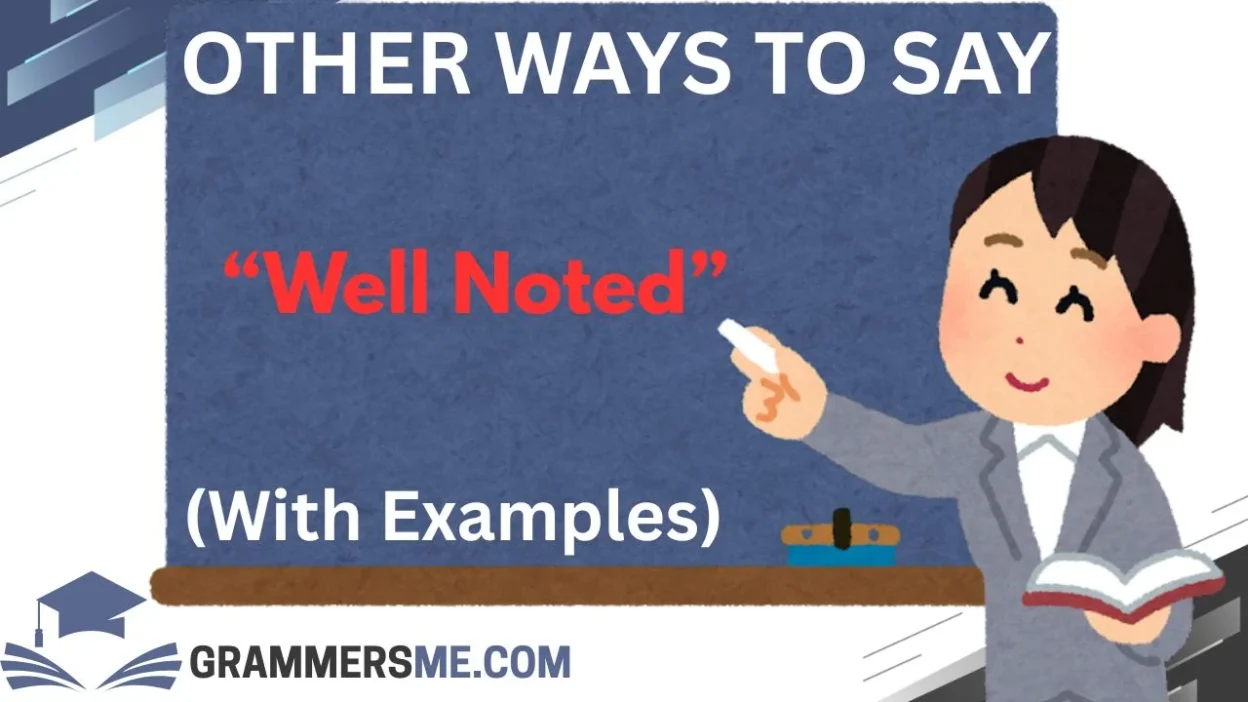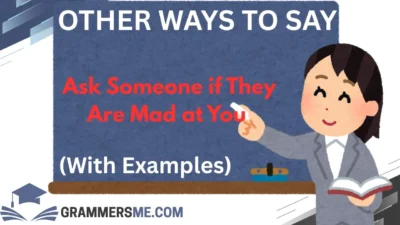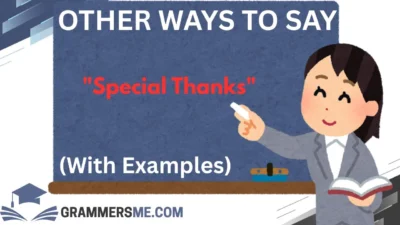When communicating, whether in professional settings or casual conversations, expressing care and thoughtfulness through the right words can make all the difference. We all know the importance of acknowledgment, but sometimes saying “Well noted” can feel a bit too formal or impersonal.
In this article, we’ll explore 30 alternatives to “Well noted” that offer a warmer, more engaging, and thoughtful way to respond. Whether you want to sound more empathetic, professional, or friendly, these alternatives can help you express yourself more meaningfully.
What Does “Well Noted” Mean?
Before we dive into alternatives, let’s first clarify what “Well noted” typically means. It’s a way of acknowledging someone’s message, implying that you have understood or registered the information. It’s often used in professional or formal settings to confirm receipt of details without offering much emotional warmth.
Is It Professional/Polite to Say “Well Noted”?
While “Well noted” is indeed professional and polite, it can sometimes feel detached or robotic. Depending on the context, you might want to choose a more personable alternative to maintain a warm, respectful tone. It’s all about finding the right balance between professionalism and genuine care.
1. “Got it!”
Meaning: A casual way of acknowledging that you understand or have received the information.
Detailed Explanation: “Got it!” is often used in informal settings or when you want to quickly convey that you’ve understood. It’s not the most formal, but it’s friendly and to the point.
Scenario Example: A colleague quickly explains the details of a project, and you respond with, “Got it!”
Best Use: Casual conversations, informal work environments.
Not Use: When you need to convey more professionalism or formality.
2. “Understood”
Meaning: A more formal and clear way of acknowledging understanding.
Detailed Explanation: “Understood” conveys that you’ve fully grasped the message or instructions. It’s still polite but a step up in formality from “Got it!”
Scenario Example: Your manager explains a new process, and you respond with, “Understood.”
Best Use: Professional settings, situations where clarity is important.
Not Use: In very casual or friendly conversations.
3. “Noted with thanks”
Meaning: A slightly more formal acknowledgment that includes gratitude.
Detailed Explanation: This phrase not only shows that you’ve taken note of the information but also adds a layer of appreciation. It’s professional and polite while showing you value the input.
Scenario Example: A client sends important feedback, and you reply, “Noted with thanks.”
Best Use: Business settings, when acknowledging feedback or important information.
Not Use: Casual interactions with friends or peers.
4. “I’ll take care of that”
Meaning: An assurance that you will handle the task or action that has been mentioned.
Detailed Explanation: This phrase reassures the speaker that you’ve understood their request and that it’s already being taken care of. It’s helpful when you want to show responsibility.
Scenario Example: A colleague asks you to handle a specific task, and you reply, “I’ll take care of that.”
Best Use: In a work setting when you’re asked to do something.
Not Use: When you have no intention of following through or when it’s unnecessary.
5. “Acknowledged”
Meaning: A formal and neutral way of confirming you’ve received and understood the information.
Detailed Explanation: “Acknowledged” is more formal than “Got it!” but still conveys understanding. It’s a safe bet for professional settings.
Scenario Example: You’re coordinating with a team, and they send you an update. You reply, “Acknowledged.”
Best Use: Formal and professional situations.
Not Use: In casual or informal conversations.
6. “I’ve taken note”
Meaning: A way of indicating you’ve made a mental or physical note of the information shared.
Detailed Explanation: This phrase shows attentiveness and indicates you’ve registered the message or request.
Scenario Example: After a meeting, you might say, “I’ve taken note of your feedback” to assure the speaker you’re paying attention.
Best Use: Professional settings where clarity and record-keeping are important.
Not Use: In very casual conversations where a simpler response might suffice.
7. “Got it, thanks!”
Meaning: A more casual yet polite way of acknowledging something while expressing gratitude.
Detailed Explanation: Adding “thanks” to “Got it” turns the phrase into a more appreciative and friendly response.
Scenario Example: Your coworker reminds you about a task, and you reply, “Got it, thanks!”
Best Use: Informal interactions, friendly work settings.
Not Use: When you need to maintain formality.
8. “I’ll make sure to remember”
Meaning: A promise to keep the information in mind and act accordingly.
Detailed Explanation: This shows that you not only acknowledge the message but also that you’ll take action based on it.
Scenario Example: A friend reminds you to bring something, and you respond, “I’ll make sure to remember.”
Best Use: When confirming you’ll take action.
Not Use: If you’re unsure or haven’t committed to the action.
9. “Consider it done”
Meaning: A confident and enthusiastic way to confirm you’ll complete the task.
Detailed Explanation: “Consider it done” is assertive and implies that the task is already in progress or will be completed immediately.
Scenario Example: Your boss asks you to handle an urgent task, and you respond, “Consider it done!”
Best Use: Professional settings where you want to convey confidence and speed.
Not Use: When you’re unsure if you can complete the task.
10. “I’ve got that on my radar”
Meaning: A way to indicate that the task or information is being actively considered and is important to you.
Detailed Explanation: This phrase suggests that you are actively aware of the task and that it’s on your list of priorities.
Scenario Example: A colleague reminds you about a deadline, and you reply, “I’ve got that on my radar.”
Best Use: In situations where you need to show attention to detail without necessarily giving an immediate response.
Not Use: When immediate action is required.
11. “Message received”
Meaning: A way to confirm that you’ve received and understood the information.
Detailed Explanation: “Message received” is often used when you want to confirm receipt of an email or important message in a professional or casual manner. It’s both polite and neutral.
Scenario Example: You receive an email from a colleague with instructions and reply, “Message received.”
Best Use: In both professional and casual settings when you want to assure someone that their message has been understood.
Not Use: In more personal conversations, as it can sound overly formal.
12. “I’ll keep that in mind”
Meaning: Acknowledging the information with the intention to remember and apply it later.
Detailed Explanation: This phrase shows that you are considering the information and will not forget it. It’s often used when someone provides helpful advice or instructions.
Scenario Example: A friend offers a suggestion for an event, and you respond, “I’ll keep that in mind.”
Best Use: When someone gives advice or an idea that you want to remember for future use.
Not Use: If the information requires immediate action, as it might sound like you’re procrastinating.
13. “I appreciate the update”
Meaning: Expressing gratitude for the information provided.
Detailed Explanation: This phrase is perfect when someone has taken the time to inform you about something. It shows that you value their communication.
Scenario Example: A team member sends you a project update, and you reply, “I appreciate the update.”
Best Use: When you want to show gratitude in both professional and casual settings.
Not Use: If the update isn’t something you wanted or needed to hear.
14. “Thanks for the heads-up”
Meaning: Thanking someone for providing information or warning you in advance.
Detailed Explanation: This phrase is often used when someone gives you important information that allows you to prepare or act accordingly.
Scenario Example: A colleague warns you about an upcoming change in a schedule, and you respond, “Thanks for the heads-up.”
Best Use: In casual or semi-formal settings where you want to show appreciation for a timely warning.
Not Use: When the information is irrelevant or not helpful.
15. “I hear you loud and clear”
Meaning: A playful yet firm way of confirming that you understand the message.
Detailed Explanation: This phrase conveys strong understanding, often in a more conversational or friendly tone. It’s not overly formal but is clear and firm in its acknowledgment.
Scenario Example: A friend explains their thoughts on a topic, and you respond with, “I hear you loud and clear.”
Best Use: In casual or friendly conversations, when you want to show you’re fully engaged.
Not Use: In very formal or professional contexts, as it can sound too informal.
16. “I’ve got that covered”
Meaning: A way to confirm that you’re handling the task or information.
Detailed Explanation: This phrase indicates that you’re on top of things and assures the other person that there’s no need to worry.
Scenario Example: Your boss assigns you a new responsibility, and you reply, “I’ve got that covered.”
Best Use: When you want to reassure someone that a task is being taken care of.
Not Use: If you aren’t sure you can handle the task or when the task is too complex to handle easily.
17. “I’ll make a note of that”
Meaning: A way of saying you will record or remember the information.
Detailed Explanation: This is a more formal way of acknowledging that you’ve taken note of something, particularly when the information might be important later.
Scenario Example: Your team leads you through the agenda for an upcoming meeting, and you respond, “I’ll make a note of that.”
Best Use: Professional environments where attention to detail is critical.
Not Use: When you don’t need to actively remember the information.
18. “Consider it registered”
Meaning: A formal way to confirm that the information has been noted or acknowledged.
Detailed Explanation: This phrase is more formal and used in professional contexts to imply that the information has been officially received and recorded.
Scenario Example: After a colleague provides feedback on a report, you respond, “Consider it registered.”
Best Use: In formal professional communications.
Not Use: In casual, friendly conversations where a less stiff response might be more fitting.
19. “I see what you mean”
Meaning: A way to acknowledge that you understand someone’s point of view or message.
Detailed Explanation: This phrase is conversational and shows empathy, often used when you’re having a discussion or when someone explains something to you.
Scenario Example: A friend explains a complex situation, and you reply, “I see what you mean.”
Best Use: In personal conversations or situations where understanding someone’s perspective is key.
Not Use: In professional settings that require a more formal acknowledgment.
20. “Thank you for sharing that”
Meaning: A way to express gratitude for the information provided.
Detailed Explanation: This is a polite and thoughtful way to acknowledge that someone has shared important information with you, showing appreciation.
Scenario Example: A colleague shares an important update with you, and you respond, “Thank you for sharing that.”
Best Use: When you want to show gratitude for information, especially in professional environments.
Not Use: When the information isn’t relevant or appreciated.
21. “Message acknowledged, thank you”
Meaning: A formal and polite way to acknowledge receipt of a message, often with added appreciation.
Detailed Explanation: This combines acknowledgment with gratitude, making it suitable for both professional and semi-formal conversations.
Scenario Example: A client provides an update, and you reply, “Message acknowledged, thank you.”
Best Use: In professional settings where both acknowledgment and gratitude are important.
Not Use: In casual, informal conversations.
22. “I’ve taken that into account”
Meaning: Confirming that you have considered the information provided and will factor it in.
Detailed Explanation: This phrase indicates that you’ve thought about the information and will make it part of your decision-making process.
Scenario Example: A colleague offers a suggestion during a meeting, and you reply, “I’ve taken that into account.”
Best Use: When you want to show that the information will influence your actions or decisions.
Not Use: When you won’t actually consider the information in your decision-making process.
23. “Thanks for letting me know”
Meaning: A polite way to express appreciation for the information shared.
Detailed Explanation: This phrase conveys both acknowledgment and gratitude. It’s appropriate for both formal and informal settings, and it shows that you appreciate the communication.
Scenario Example: A friend tells you about a change in plans, and you reply, “Thanks for letting me know.”
Best Use: Casual to semi-formal conversations when showing appreciation is important.
Not Use: When the information is not appreciated or helpful.
24. “That makes sense”
Meaning: Confirming that you understand and agree with the information or explanation provided.
Detailed Explanation: This phrase is often used when someone explains something, and you want to confirm that it’s clear to you.
Scenario Example: A colleague explains a new procedure, and you reply, “That makes sense.”
Best Use: In conversations where you want to show understanding and agreement.
Not Use: When you don’t understand the information or disagree with it.
25. “I’m on it!”
Meaning: An enthusiastic and confident way to express that you are handling the task or information.
Detailed Explanation: This phrase shows eagerness and confidence that you’re taking action or addressing a task right away.
Scenario Example: A manager asks you to tackle a priority project, and you reply, “I’m on it!”
Best Use: In professional settings where you want to show initiative and enthusiasm.
Not Use: When you don’t have the time or resources to actually tackle the task.
26. “That’s good to know”
Meaning: A way to acknowledge information while also expressing that it’s useful or important to you.
Detailed Explanation: This phrase shows that you appreciate the information and find it relevant or valuable.
Scenario Example: A friend shares helpful advice, and you respond, “That’s good to know.”
Best Use: In casual settings or when the information shared is useful but doesn’t require immediate action.
Not Use: When the information is not something you care about.
27. “I appreciate the clarification”
Meaning: Expressing gratitude when someone helps clear up confusion or provides additional details.
Detailed Explanation: This phrase is a polite and appreciative way to acknowledge that you’ve received clarification and now understand the situation better.
Scenario Example: A colleague explains something you were unsure about, and you respond, “I appreciate the clarification.”
Best Use: When you’ve had some confusion and someone helps clear it up.
Not Use: When the explanation didn’t actually help or if no clarification was needed.
28. “I’ll follow up on that”
Meaning: Confirming that you’ll take the next steps and ensure the task or request is addressed.
Detailed Explanation: This phrase signals that you will take action and check in later to ensure everything is on track.
Scenario Example: After discussing a pending task, you reply, “I’ll follow up on that.”
Best Use: When there are pending actions, and you want to show commitment to ensuring things move forward.
Not Use: If you have no intention to follow up.
29. “Noted, I’ll proceed accordingly”
Meaning: A formal and precise acknowledgment that you’ve registered the information and will act accordingly.
Detailed Explanation: This phrase is professional and assures the other person that you’ll take the necessary actions based on the information received.
Scenario Example: A supervisor gives you instructions for a project, and you reply, “Noted, I’ll proceed accordingly.”
Best Use: In formal business environments where clarity and professionalism are important.
Not Use: In informal or casual interactions where a simpler phrase would suffice.
30. “Thanks for the reminder”
Meaning: Acknowledging that you were reminded of something important and expressing gratitude.
Detailed Explanation: This phrase is useful when someone helps jog your memory about something you might have forgotten.
Scenario Example: A friend reminds you about an upcoming event, and you reply, “Thanks for the reminder.”
Best Use: Casual conversations, when you want to show appreciation for the reminder.
Not Use: When the reminder isn’t helpful or you’re not thankful.
Conclusion
Selecting the right phrase for acknowledging information can make a significant difference in how your communication is received. Whether you’re looking to sound more formal, friendly, or engaged, there are plenty of alternatives to “Well noted” that can make your responses more thoughtful and personal. Choose a phrase that reflects both the tone of the conversation and your relationship with the person you’re speaking to.
Frequently Asked Questions
- Can I use “Got it” in a professional setting?
- Yes, but it’s best used in more casual professional environments or when communicating with familiar colleagues.
- Yes, but it’s best used in more casual professional environments or when communicating with familiar colleagues.
- What should I say instead of “Well noted” to express more gratitude?
- Phrases like “Noted with thanks” or “Thanks for the update” convey more appreciation.
- Phrases like “Noted with thanks” or “Thanks for the update” convey more appreciation.
- What’s the most formal alternative to “Well noted”?
- “Acknowledged” or “Noted, I’ll proceed accordingly” are both formal and professional alternatives.
- “Acknowledged” or “Noted, I’ll proceed accordingly” are both formal and professional alternatives.
- How can I make my responses sound warmer and more personal?
- Try using phrases like “I appreciate the update” or “Thanks for the heads-up” to sound more approachable and caring.
- Try using phrases like “I appreciate the update” or “Thanks for the heads-up” to sound more approachable and caring.
- Is it okay to say “I hear you loud and clear”?
- It’s fine in casual settings, but for professional contexts, opt for something more neutral like “Understood” or “Acknowledged.”




